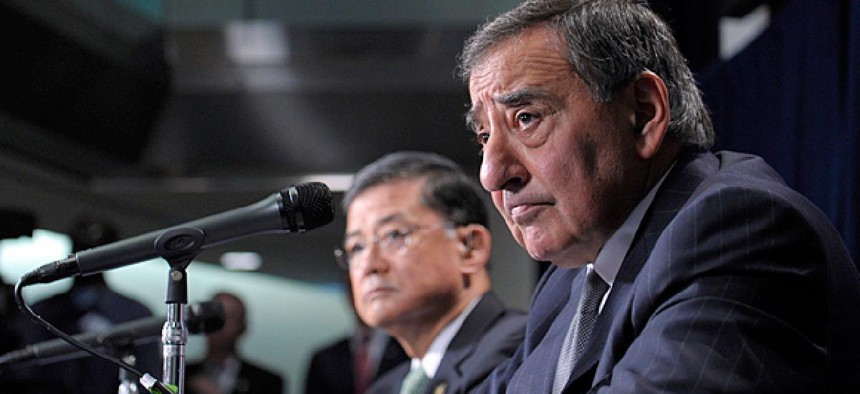Defense and Veterans Affairs aim to speed up joint health record rollout

Defense Secretary Leon Panetta and Veterans Affairs Secretary Eric Shinseki at a joint news conference Dec. 6, 2012. Susan Walsh/AP
Departments will ‘meet or beat’ original plan for full deployment by 2017.
This story has been updated.
Defense Secretary Leon Panetta said Thursday that he and Veterans Affairs Secretary Eric Shinseki have agreed to accelerate deployment of an integrated electronic health record to serve both departments.
Panetta said he and Shinseki agreed to “meet or beat” the planned schedule for iEHR deployment in a meeting at the Veterans Affairs Department headquarters, but he provided no details. At their last joint press conference in Chicago in May, Panetta and Shinseki forecast full deployment of the iEHR in 2017.
The two departments plan to roll out an early version of the iEHR with joint lab and pharmacy systems to hospitals in Norfolk, Va., and San Antonio in 2014. As he has in the past, Shinseki emphasized that the iEHR will be based on an open architecture with non-proprietary software.
Panetta said development of the iEHR is a “tough effort [that requires both departments] to confront technical and bureaucratic challenges.” He said he expected VA and the Defense Department to approve a new schedule for the iEHR next month.
When the two departments complete the iEHR deployment, it will stand as the largest electronic health record system in the world, serving 7.8 million veterans and 9.7 million military personnel through 59 military hospitals and 152 VA hospitals with a combined staff of more than 350,000.
Both secretaries agreed their departments need to do more to fix the disability claims process, described as a work in progress. Panetta called the backlog a “national security issue” because how today’s veterans are treated will affect tomorrow’s recruitment.
Panetta said that to provide a better baseline for medical claims, Defense plans to conduct more detailed exit physicals for troops, which will provide VA with more detailed information when a veteran files a claim.
While VA currently processes more than a million claims a year, Shinseki said, “a million-plus claims come in the door” as troops who served in Iraq and Afghanistan leave active duty. As of Dec. 3, the VA disability claims backlog stood at 896,025, with 602,483 or 67.2 percent of those claims delayed for more than 125 days.
Shinseki said VA has deployed its paperless Veterans Benefit Management System to 18 out of its 59 regional offices this year, with all offices scheduled to use the system next year. The move is the result of a $491 million investment over the past three years and should speed up claims processing, he said.
Asked if troops and veterans diagnosed with post-traumatic stress disorder are prescribed too many addictive drugs, such as opiates and benzodiazepines, Shinseki replied, “I think we need to be courageous enough to ask ourselves if we are over-medicating.” He added that he had his own opinion but preferred not to express it until he receives a report on the use of addictive medications.
Panetta said both departments need to find ways besides medication to deal with PTSD, and if pills are prescribed, they should be used “to meet the problem…not go beyond it.”
Panetta and Shinseki agreed their departments must address a wide range of mental health issues that have led to an epidemic of suicides among both active duty troops and veterans. Panetta said VA and Defense together need to build an “integrated veteran support system” that handles all issues confronting veterans.
He added such a joint effort “can’t be about turf…it’s about serving veterans [and] collaborating better than in the past.”



